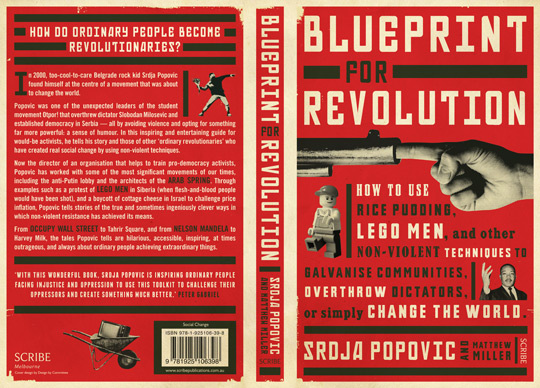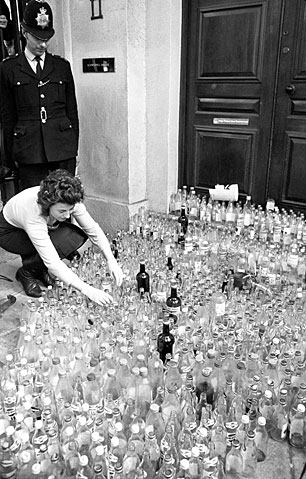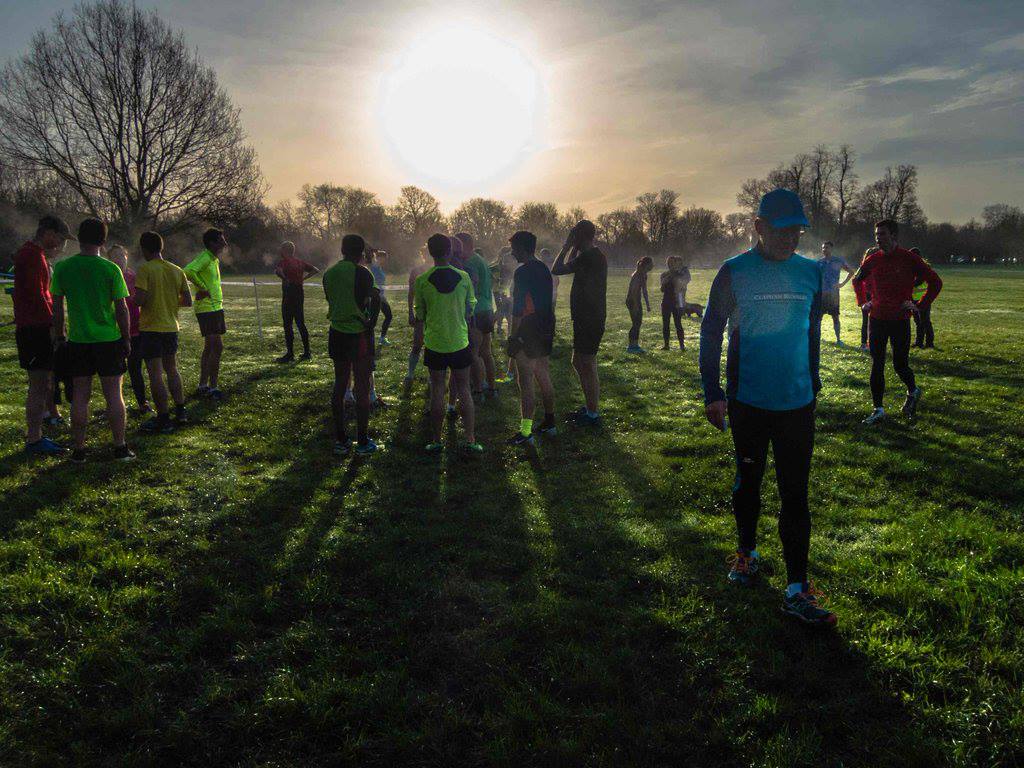For those concerned that this is becoming a blog about political theory. Fear not. Normal service will soon resume.
But a skill for any campaigner is considering how the changing external context is affecting the issue that they’re campaigning on. As a result over the last few months I’ve been thinking a lot about what the uncertain and turbulent times mean for the political context we find ourselves in.
For a long time we’ve considered politics to be about right and left, and tried to place our targets and audiences on that. We’ve always know it was a little simplistic – David Bull explores this some more – but it works when thinking about who to target and who we need to demonstrates supports our issue or cause.
When you have a right of center government you have to consider who are the allies that you might be able to build on the right that you can engage in your coalition, or think about how you frame your message to appeal to ‘right of center’ voters. And the same happens when you have a left of center government.
But so much feels like it’s changed over the last 12 months I’ve started to think about different approach when considering where we place our targets – especially if the negotiations around Brexit dominate the political debate in the UK over the coming years
Instead of thinking about Left – Right, I’ve been thinking about needing to work from a Populist – Establishment/Internationalist – Isolationist matrix.
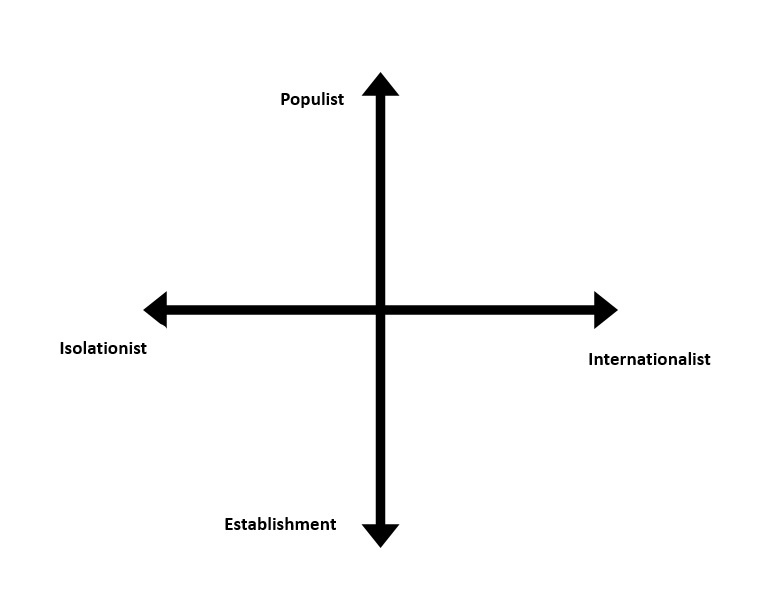
It’s built on the premise that perhaps there are groupings across political parties that have as much in common as others within their parties – we’ve long known that there are factions within parities – but the referendum seems to highlight new alliances across parties – see the emergence of More United led by Paddy Ashdown, or the continuation of Britain Stronger In becoming Open Britain with strong cross party support.
Populist or Establishment – Lots has been written about the rise of Sanders and Corbyn on the political left, or populist movements on the right across Europe and beyond – all of whom have been able to position themselves as ‘anti establishment’. While part of the reason the Remain campaign failed in the EU referendum was that it wasn’t able to shed an establishment image against the more populist message that was being pushed by Vote Leave. This axis also throws up some interesting challenges for me about how many campaigning organisations and our messages are perceived – are we seen as too much part of the ‘establishment’?
Internationalist or Isolationist – this is a question about the range of policies that people want to see enacted, especially when it comes to Brexit. Internationalists are those that believe that the big challenges we face can only be solved by cooperation and collaboration across boundaries. Isolationists on the other hand believe that first and foremost it’s about solving the problems at home – it’s about ‘taking back control’ or ‘pulling up the drawbridge’ depending on your viewpoint.
But if that’s about political targets. What about the public?
This recent research from Social Market Foundation is well worth diving into. It suggests the public could now be grouped into eight political tribes – these aren’t going to replace the existing parties, but highlights that the political views of the public are more complex, and might shape the possible policy directions of the existing parties, as any good politician is going to think about how they can build an electoral coalition that can win.
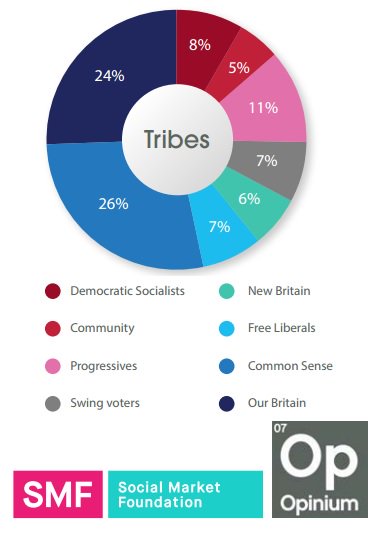
I’ve tried to place the tribes onto the Populist – Establishment/Internationalist – Isolationist matrix – which is interesting to consider – especially when you reflect on the relative sizes of the different tribes.
The Social Market Foundation suggest that Our Britain accounts for 24% of the population, compared to 5% for the Community tribe. I think it shows that there is possibly a clear pull towards the Populist/Isolationist side of the matrix which could presents challenges that campaigners are going to have to overcome if politicians feel the need to tack towards that group to sure up electoral support.
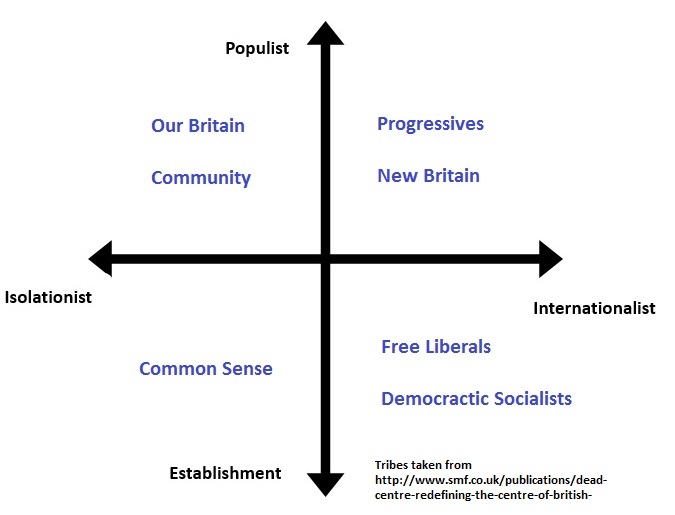
I’m not suggesting that campaigners should adopt policies that will appeal to the Our Britain tribe, but as I’ve long argued, as campaigners we need to spend more time considering different perspectives, and understand that we often live in a bit of a ‘bubble’ so we need to become more aware of different tribes. This means finding ways our messages could resonate with other tribes, or find ways of expanding the tribes that support our calls, or at least giving the impression of more size.
Right, that’s the political theory lesson over – normal service will resume next week, but I’m interested in what people think – as a passionate internationalist I’m concerned about the need for voices in the populist and internationalist box that can energize and engage.
10 reflections from NCVO Campaigning Conference
It was the NCVO Campaigning Conference yesterday – it’s always an interesting day bringing together a mix of campaigners and public affairs colleagues from across a range of issues.
As always you walk away with a notebook – or in my case multiple scraps of paper – full of notes, thoughts, good ideas and top tips – and a frustration you couldn’t be in more than one session.
Here are 10 things that I took from my morning at the Conference – do check out #ncvocc for more insight.
1. Brexit is the focus for government – both Jess Phillip MP and Jonny Mercer spoke about how the Brexit negotiations will dominate everything that happens in Parliament and Whitehall in the coming years. It’s not just because it’s the most important political decisions that many of us will see in our lifetimes, but it’s also because it’s taking up so much capacity from civil servant and ministers other issues are getting pushed to the side. Campaigners looking to get noticed will have to push harder than ever.
2. MPs really are tired of email petitions – so this isn’t news, and you almost expect to hear it from MPs in sessions like this, but when two pro-campaigning MPs who are instinctively on our side tell you that they’re fed up of pre-written email petitions, you know it’s time to think long and hard about if the tactic is doing more to hinder than help. Jess reminded us that she get’s over 6,000 emails every day, and the response to any pre-written email is to ensure a member of staff responds with a standard template email.
3. It’s MPs staff you should be getting to know – they’re the gatekeepers to most MPs, the ones who make key decisions about diaries and briefings. Build good relationships with them and it can really help you to get your campaign in front of an MP. Treat them badly and don’t expect to see much progress.
4. Ask do you really need to be in a coalition – I was fortunate to chair a really lively and interesting session on coalition campaigning. Jane Cox from Principle Consulting reminded us that there is a cost to coalitions (perhaps Jane had ready my blog on this) – sometimes a strategic partnership is a better approach than the time commitment an effective coalition can be. Jane wrote a really useful post with some of her learning from coalition campaigning.
5. Keep going until the end – too many coalitions just focus on the immediate change outcome, and when they’ve succeeded in delivering that they stop. That can be a mistake and often ensuring that you monitoring implementation is as important. This is something that you should factor into your planning – especially when applying for foundation support for your campaign.
6. We need to talk about power – Heather Kennedy from the Fair Funeral Campaign reminded us of the principle from organising that you either have organised money or organised power – if you’re opposition is organised money it can be easy for them to ‘sit it out’ until you’re coalition has come to an end. It was one of the few references through the day to power – which given campaigning is often about winning feels like it was something missing from the conversation.
7. Celebrate success in a generous way – Heather shared about how the Funeral Poverty Alliance has built it’s coalition over the last few years and managed to put the issue on the agenda – it sounds like a really great campaign coalition which doesn’t have lots of governing documents but has placed building relationships through well facilitated strategy sessions and strong face-to-face relationships. Demonstrating that coalitions don’t have to be dominated by ‘egos and logos’!
8. When developing campaign leaders high commitment should mean high support – I really enjoyed the session on developing volunteers as campaign leaders – it felt that there was a recognition that in response to the declining effectiveness to e-petitions we need to look again at building our networks.
I’ve been aware of the work that Alice Fuller and her team at the MND Association have been doing at building a network of Campaign Contacts in their local groups over the last few years, but it was great to hear more about it – and to hear some honest reflections about how much the team have learnt about the level of support they need to provide, the commitment to training and investing in volunteers, but also letting go and trusting volunteers.
9. Metrics matter – Eleanor Bullimore spoke about the work, and the challenge of developing relevant metrics to measure the impact of the work that volunteer network at The Ramblers is having. Elle suggested that as well as developing metrics for going up the the ‘ladder of engagement’ we also need to be looking at those going down – recognising that some volunteers will find they have less rather than more to offer.
10.Trust us – Joining Alice and Eleanor was Katy Styles, one of MND Associations local campaigners. It was so refreshing to hear of the ways that Katy had been able to get involved in leading MND’s campaign (Katy has helped to produce this cracking toolkit) – and to be reminded that most people aren’t paid to campaign they do it because of a passion. The big message that I’m taking from Katy was as professional campaigners we need to let go of our concerns about brand and reputation and trust our volunteers.
Update – all the presentations from the sessions are available here.
Book Review – Blueprint for Revolution
One of the things I most enjoy about going on holiday is the opportunity to dip into a good book or two.
Over the last week I’ve really been enjoying Blueprint for Revolution – How to Use Rice Pudding, Lego Men and Other Non-Violent Techniques to Galvanise Communities, Overthrow Dictators or Simply Change the World by Srdja Popvic.
Popvic is one of the leaders of the CANVAS (The Centre of Nonviolent Actions and Strategies), the Serbian based organisation that was behind the movement overthrowing Slobodan Milošević, and has taken these lessons to help other movements around the world (this is a good read on the work of CANVAS).
It’d be easy to think that the book is only intended for those who are interested in learning about overthrowing dictators, but it’s not. I found the book packed full of practical insight and brilliant stories that are relevant to anyone involved in campaigning.
It’s an easy and enjoyable read, with Popvic mixing a range of stories from his personal experience with lessons from history.
I’ll be recommending it to anyone who asks me about what makes a good campaign as it’s packed full of practical wisdom that could be applied to anyone involved in movement building.
Here are a few lessons I’m walking away with after reading the book that I’ll be looking to apply in my campaigning;
1 – Focus on small victories to build your movement – those campaigns that focus first on small achievable battles that they can win are more likely to succeed. They understand that victories can help to give your supporters confidence that they’re part on a winning side, and also help to attract others to your cause.
2 – It takes time to plan your strategy – Popvic shares a lot about the time Otpor! in Serbia took to plan and build for the actions that they then took. He’s at time critical of movements that he feels have moved to action too quickly. To be successful you need to be meticulous as you can in your planning and preparation. Leave nothing to chance.
3 – Change comes when two or more groups come together for mutual benefit – campaigns can’t be won if they just reflect the views or worldview of just one group with a community – they need to bring together different groups. Throughout the book is the message that building unity, community and trust with others is central to anyone who wants to win.
4 – Focus on the ‘Pillars of Support’ – remembering the work of Gene Sharp, who suggested that every regime is held in place by a handful of pillars – apply enough pressure to one or more pillar, and the whole system will soon collapse. But this means thinking laterally and considering what the pillars are – for example for using businesses which have close connections with those you’re looking to target. See this for how the concept has applied to the campaign for equal marriage.
5 – Make it funny – campaign can be a serious business, but Popvic is a big advocate of using ‘laughtivism’ as a tool for change, using humor as a way of undermining your target, but having some fun at the same time.
The book is, as they say, available from all good bookshops – I’d highly recommend it.
How Theory of Change can help your campaign win gold
Suggesting campaigners spend some time thinking about Theory of Change doesn’t normally elicit the same energising response that cheering on Team GB in the Olympics does!
So while I’ve been spending the last two weeks watching the Olympics, it’s got me thinking about winning and the approach that UK Sport has taken to ensure this was our greatest ever Olympics.
It strikes me that they have an incredibly clear theory of change about how they we’re going to approach Rio 2016 and build on the success from London 2012.
But what could campaigners learn from the rush of medals Team GB has won in the last fortnight?
Alongside other colleagues at Bond, we’ve been working with Jenny Ross to produce resources on Theory of Change which we hope will help to provide a useful introduction, and encourage more campaigners to use it as an approach.
Theory of Change is a key approach for any campaigner who is serious about winning to take, but one I think many of us shy away from as it’s been built up into that’s impenetrably complicated, so we hope that this video and accompany resource will help to make it more accessible.
So drawing on the lessons from the success of Team GB here are a few thoughts on how theory of change can help you approach planning your campaigning;
1. Be clear on what success looks – It’s simplistic to suggest that all Olympic athletes are going for Gold. Yes that’s what they want to achieve, but many realise it’s unlikely, but for sports that UK Sport funds it’s clear on how many medals they’re looking to achieve.
Using Theory of Change can help you be clear on what your specifically looking to achieve and be able to articulate it for all those your working with.
2. Map out the route to success – Listen to any of the Olympians and they’ve been successful by building up to the competition in Rio. It has come about through months and years of planning and meeting milestones on the way – achieving certain targets in training, winning an important competition, etc.
In the same way using Theory of Change can help you to set out what the progress on the way that you expect to see before winning the overall change – it helps you to map out the goals that you need me to meet on the way.
3. Challenge your assumptions – One of the issues where UK Sport has been criticised is the way it ruthlessly allocates resources to sports where it believes it has a medal opportunity, even when they’re unpopular. It’s a harsh approach but one which clearly produces results by making sure resources are going to the right place.
In Theory of Change, we’re asked to test our assumptions and to make sure that the resources we have are being allocated in the most effective way to deliver the outcome – just because we’ve always done something doesn’t mean we should continue to do it.
4. Look for marginal gains – Those being Team GB success in the velodrome are famous for a focus on marginal gains, which is all about small incremental improvements in any process adding up to a significant improvement when they are all added together. It means when it comes to winning nothing is left un-investigated.
Theory of Change asks us to think about the context within which we’re working, and what that will mean for the work. To investigate and consider all the factors that might help or hinder us on our route to winning.
5. Reflect, review and repeat – Listen to the interviews with officials in UK Sport and they’re already planning for Tokyo 2020, building on the success and learning of the last 16 days.
It should be the same with Theory of Change, it isn’t just a document to be produced and forgotten. It should be a living document that responds and reacts to – looking forward to the next opportunity.
Getting the most from your time as a intern
I’m re-posting some of my favorite and still relevant posts from the archives. This post still feels relevant for those starting internships and volunteer this summer. It also provides me the opportunity to highlight;
- Applications for the next Campaign Bootcamp are open, including a stack of awesome scholarships that are available to help anyone who wants to come.
- I’m looking to recruit a Campaign and Policy Trainee to join the team at Bond. Applications close on Wednesday. It’s a great role, paid at the London Living Wage, for someone looking to make a start working in an exciting team (and with me!)
School’s out for the summer for university students, and some will be heading into summer internships with campaigning organisations across the UK and beyond.
Doing an (hopefully paid) internships is one of the routes for getting a permanent job in campaigning, it’s also a good way of finding out that this perhaps isn’t the career for you.
I’ve been fortunate to have hosted lots of great volunteers, interns and trainees in the organisation I’ve worked in over the years, and as such come up with my 8 top tips for getting the most out of your time as a volunteer/intern with a campaigns team.
1. Be honest – Find out why you’re being asked to do the tasks your being asked to do. Some of them won’t be glamorous, but there should be a good reason for everything you’re being asked to do. Asking lots of questions is one of the best ways of understanding how different tactics and approaches come together to make a campaign.
2. Be clear – Make sure you get the time you need at the start of your time with an organisation to understand what they want you to achieve from your time, and for you to explain what you hope to achieve. If there are certain areas that you’re interested in finding out about more, ask at the start as it’s often possible to arrange something. Be clear what your objectives from the time you’ll be volunteering are.
3. Be in the room – I always try to make an effort to invite volunteers and interns to different meetings that are going on. Some of them are directly related to a project they may be involved with, but often I see them as a good opportunity to learn. If you’re invited to these meeting, GO. You’ll almost certainly get an insight that you wouldn’t have done if you’d just stayed at your desk.
4. Be bold – It can be intimidating being a volunteer or intern, but be bold and if you think that somethings been overlooked in a meeting or if you have a good idea to contribute speak up. Chances are those involved will welcome the new insight that you’re able to bring.
5. Be a networker – Make time to try to get to know others around the organisation, approach people from different teams and ask if you might be able to meet them for lunch to find out more about their work. They’ll probably be happy to share more about it, go with some good question and you’ll come back an hour later with a better picture of how the work you’re doing links with the work of the rest of the organisation.
6. Be a learner – Ask those you’re working with for suggestions of good books, websites, reports and resources. It’s a good way to learn more about the campaigning craft and find out how others do it. Many organisations also have lunchtime sessions with internal/external speakers, go along to these as well.
7. Be cheerful – it sounds so obvious, but bring energy into the office you work in. There is little worse that a volunteer who appears uninterested. Get involved in making the tea or partaking in whatever other office routines you encounter.
8. Give feedback – At the end of your time let those you’ve been working with know what you’ve enjoyed doing, and what you found could do with some more consideration. You’ll be helping out future volunteers/interns.
What advice would you give to those coming to intern for you this summer?
Update – The team at Bright One have also come up with an excellent list of Do’s and Don’ts for an intern.
Networked Campaigns – a winning approach?
This graph has got me thinking.
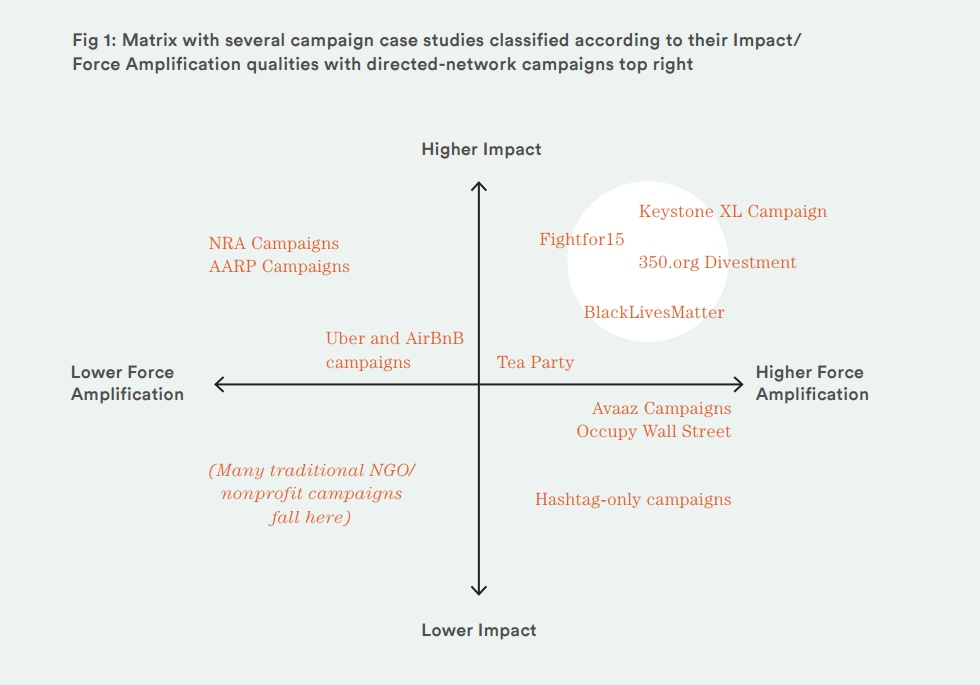
It comes from Networked Change, a report that anyone serious about thinking at what campaigning in the 21st century is going to look like needs to be reading.
Written by Jason Mogus, a consultant-cum-movement builders who’s work with a range of North American based networks it explores what are the characteristics of winning campaigns today.
In the report, Jason, with his co-author Tom Lucas, argue that those campaigns that are having the most impact and traction on issues today are those that adopt a networked approach.
It’s a theme that’s echoed in this piece by Nicole Carty, who accurately identifies that the most successful online campaigns a had ‘one essential thing in common — they had a sustained offline presence’.
Even before Brexit, I’ve been thinking if many of the campaigning models that NGOs are using aren’t fit for purpose our current age. But with Brexit and how we respond to it, it makes me feel that it’s even more important to take a long hard look and ask how do we ensure we continue to win.
Where are we at the moment?
Jason and Tom suggest that a typology for campaigning organisations and structures could be seen as;
Membership campaigns – these are hierarchical organisations, often as a result of a democratic structure at the heart of them which set direction (and sometimes elects who’ll run them). They’re built on a structure of local groups/chapters made up of individuals who pay to be part of the organisations.
As a result they often as a result have significant resources which are drawn from membership fees, That means the structure can be accompanied by resources for insider lobbying and influencing. In the UK, you might associate this model with the Trade Unions, although elements of the membership approach exist in organisations like Friends of the Earth and Amnesty International.
Managerial campaigns again are hierarchical, but the accountability isn’t to a democratic structure, but rather to the board or management team of the organisation. Many will have advisory groups of service uses or supporters, but those groups don’t have control over the direction of the activities.
These campaigns largely direct their grassroots into the actions they should be taking, and while those grassroots are mobilised regularly, the strategic direction is controlled, and there is an emphasis on brand and staying ‘on message’ over a freedom to innovate.
Many NGO campaigns are based on this approach and arguably emerged at a time when membership organisations were in decline, but people want to engage in activism but had less time to do so, so did so by making a donation.
Mass mobilisations platforms like Avaaz and 38 Degrees which utilise the power, as a result they can be nimble and responsive to the public mood, often the tools of the platform are available to others (see Campaigns By You from 38 Degrees) but there strength is combining mass mobilisation tools, like email petitions, with high profile activities. An importance is placed on the volume of activity rather than the depth of it.
Networked campaigns according to the report are ‘they are typically led by a central body that frames the issues and coordinates energies towards shared milestones but also leaves a fair amount of freedom and agency to grassroots supporters and a diverse network of inside and cross movement allies’.
I think it’s an accurate typology, and as I look around many of those involved in NGO campaigning seem to be trying to make the move from managerial campaigns to mass mobilisation platforms.
But while that could be the right move, if you follow the logic of the lessons from the report, campaigns that want to have impact should be looking to move from bottom left to top right, building campaign approaches that harness the power.
Jason and Tom suggest that networked campaigns have the following principles;
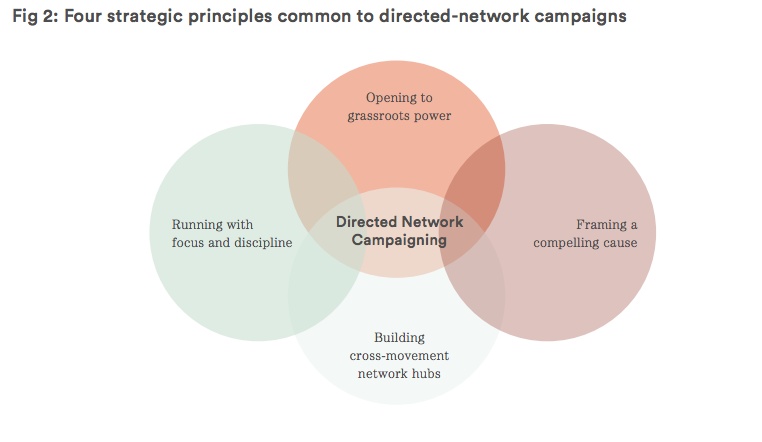
The report suggests that it’s a journey that can be made for NGO campaigning, although its’s not without its challenges.
How to respond?
So what are the steps that an organisation could take to start to make the move to taking a more networked approach? Here are some areas that could be explored first.
1 – Have super sharp political analysis – networked campaigns don’t relinquish control over the political strategy, they spot the opportunities and the weak points in their opponents. That can mean rethinking the targets and strategies to avoid asking people ‘to support an approach that is too arcane to grasp, too single-issue to make a difference, or to join a fight that seems hopeless from the beginning’ instead looking at ‘action worthy‘ problems where activism can be focused.
2 – Create ways to open feedback loops – those campaigns that succeed are ones that actively listen to those in their audience and then react and respond. According to the report ‘Active audience input and listening can take the form of polling supporters on future priorities, letting supporters suggest and initiate their own online petitions, and allowing supporters to generate their own digital campaign content through images and other forms of testimonials’.
3 – Give away more control – the most successful campaigns don’t try to control everything, but instead ‘allow their supporters to customize and adapt campaign messages and visuals to better suit their local contexts’. That doesn’t mean that anarchy has to rule, the report is clear that networked organisations ‘carefully outline roles and responsibilities for their distributed leadership, prepare a digital “toolkit” for self-starters and convene regular checkins led by central staff to ensure that problems are addressed and that the overall movement is aligned’.
4 – Make it about the issue not the brand – Managerial campaigns can often be accompanied with a strong focus on building brand profile – that’s a natural and rational decision as they’re often being funded solely by an organisations. The report suggests that ‘When the campaign is designed to be open from the beginning, to function more like a hashtag and a shared rallying point for a wider coalition of independent actors, this enables a shift from cause campaign to wider social movement, and the result is often much greater impact and reach’. While that makes lots of sense, what it doesn’t explore is how an organisation can fund such a campaign when the pressures to support activism can often be significant.
5 – Test, fail, adapt – being inspired by the tech world – networked campaigns are approaching campaigning by ‘Taking a product development approach to campaign design, organizers are led to work on rapid “iterations” of their plans and messaging with daily status check-ins between point people in various departments’. Be less risk adverse and failing fast are key characteristics.
6 – Actively look outside of usual networks – At the heart of networked organsiations are bridge builders, individuals who a comfortable operating in a networked way they are ‘network builders must actively seek out “unusual suspects”, groups that are not natural allies but are deeply impacted by campaign issues’. This by Lisa Witter is excellent on the skills that bridge builders need.
7 – Tell great stories – the report suggests that those campaigns that succeed are ones that are able to frame a compelling case. In short, they can tell a good story.
Jason and Tom draw from the work of Jonah Sachs and his Wining the Story Wars book in suggesting that campaigns need to frame messages with heroes and villains, but perhaps importantly adding that ‘Many of today’s most successful campaigns employ a storytelling strategy that casts their grassroots supporter base as the heroes in this story and give them an active role in taking the villain to task. The NGO is the mentor in the story, not the hero, and the language of “you” taking action and eventually prevailing replaces “we”.’
8 – Focus on organising to build power – I’ve explored this theme before, but perhaps this is one of the biggest difference between the networked approach that they advocate to the mass mobilisation platforms, suggesting that.
I think this quote in the report form Geoffrey MacDougall, at Consumer Reports nails it ‘“You can’t always be mobilizing. Without a clear end date or win state, you’ll just burn through people and build a machine you constantly need to feed just to stay at the same scale. Hold back your power until you’re at one of those 1/0 state moments, then go for broke.”
Brexit – some immediate thoughts for campaigners
It’s been a difficult fortnight.
From the murder of Jo Cox MP, someone I didn’t know personally but had worked with a huge number of my friends and was a tireless champion for many of the causes that matter to me, to the Brexit vote and the ongoing political fallout from it, it’s hard to identify a more difficult couple of weeks in my professional career.
Judging from the news from the last 24 hours it’s not ending yet, but here are a few initial thoughts for campaigners – I suspect these will change in the coming days and weeks!
1. Be intentional about focusing on self care – I sent this to many people I worked with on Friday. We’re in turbulent times and they’ll require us to organise, but we can’t do that without looking after ourselves. We really do need to be in this for the long-run. This is also really good on the topic. Getting together, taking time off from social media, building community are all things that matter more than ever before.
2. Get out of the city and into the country – Many have written eloquently about the implications of the divisions or splits between the parts of the country that voted for Remain and Leave. This polling from Lord Ashcroft is useful to get a sense of the difference in views on a range of issues.
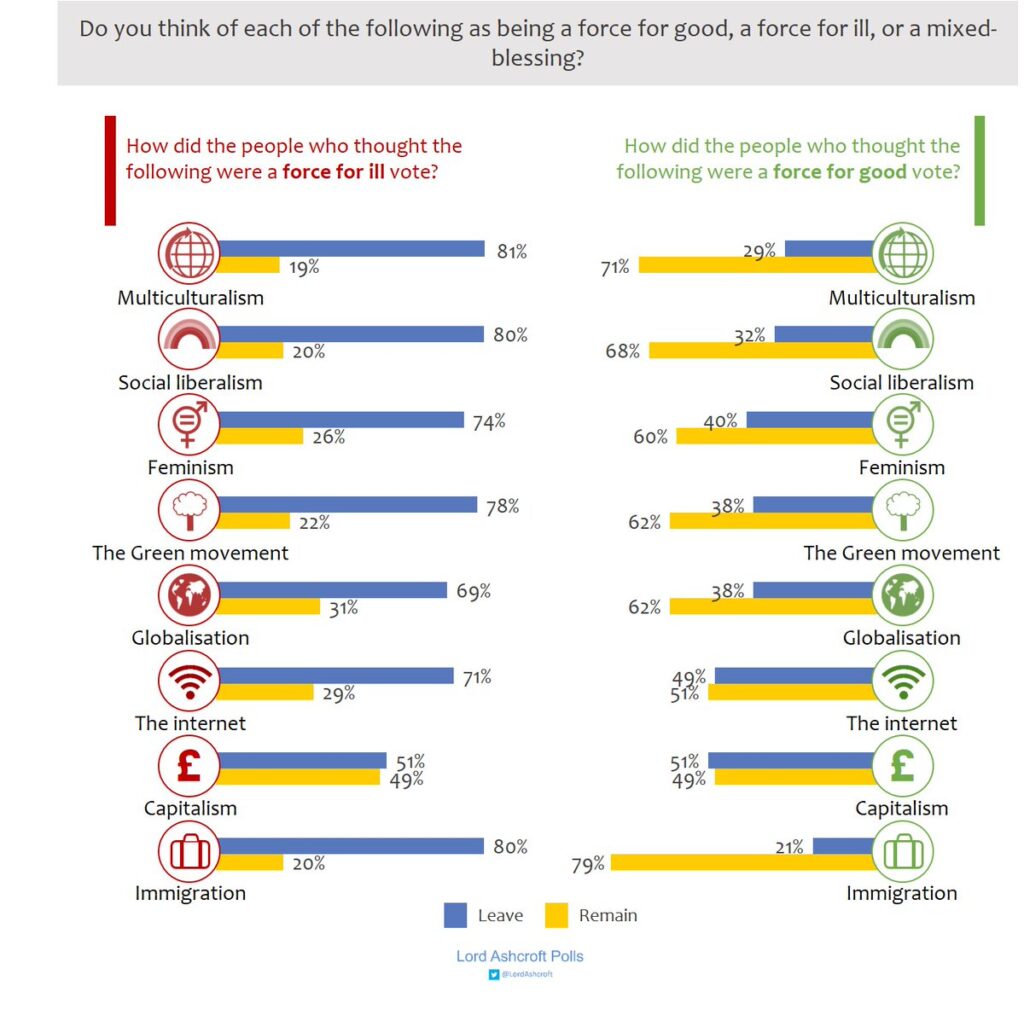
For all campaigners, if we want to grow support for our issues then we have to do that amoung enough groups to demonstrate their are political gains to be made from backing our issues – to do that will mean getting outside of the big cities. Failure to do so and there is a risk that the issues that we’re campaigning on are seen in the same way that the Remain campaign was, as part of the elite establishment.
At times like this I can’t help but think of the example of Shelter who deliberately sent there teams out and about to marginal seats to test their key messages for their 2015 election housing campaign, or Invisible Children who while found success Kony 2012 but honed their message from years and years of presentations to groups of young people.
Both are examples of campaigns that got the need to understand the way to build support is to get out and understand the public they’re looking to support their campaign.
3. Talk to people – On Wednesday evening I heard from academic Josh Kalla talk about research he’s done with community organisers in LA to prove its possible to change minds on transgender people through deep canvassing – they’ve found that from persuasion conversations you actually can change the minds of people.
But deep canvassing not only requires time and people but also listening and sharing personal stories – all resources that require investing in and are perhaps in short supply.
One of my criticisms of the Stronger In campaign was its apparent obsession with high-visibility campaigning like street stalls and leafleting outside stations. While they might have been a necessity given the resources they had, it never felt like a strategy for connecting people with personal reasons to vote Remain.
4. Recognise that expert voices don’t cut through to all – The Stronger In campaign has spent most of the campaign telling us how many experts were for Remain. I’m sure that was backed up and informed by polling, but as the polling below shows for a myriad of reasons many people don’t trust ‘experts’ any more. It means we need to think again about our messengers as well as our messages.
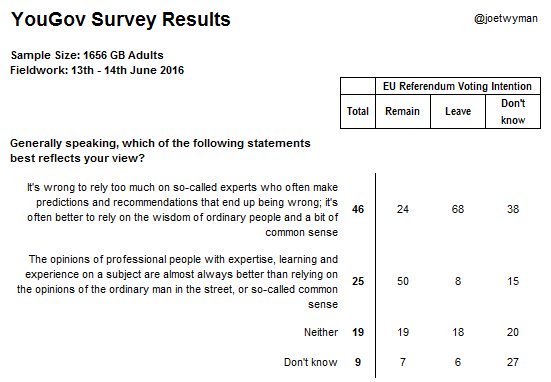
5. Bring our issues together – Our campaigning can sometimes pit one issue against another, but in wake of the referendum we need to explore how our campaigning issues are connected together and actively finding common cause. It’s a strong finding that comes out the Networked Change report (which I need to write more about) that those networks that are more successful are ones which cross movement boundaries – we need to find ways to connect issues together.
6. We are the leaders we’ve been waiting for – In the coming weeks and months we’ll need to organise ourselves with plans and strategies that respond to the situation we find ourselves in. Sometimes I live in the belief that others will be the leaders to help navigate a path forward, but if you’re reading this its down to you, me and other campaigners to explore solutions that allow us to do that.
7. We have #MoreInCommon – On Wednesday afternoon I stood with 5,000+ others in Trafalgar Square to say that we have #MoreInCommon to celebrate the life of Jo Cox. The event, which was one of 20+ around the world, was organised in just 5 days by friends and colleagues of Jo Cox. None of those friends wanted to be organising the event in such circumstances, but the way they went about wanting to celebrate the life was inspiring, helping to ensure the message from Jo Cox’s maiden speech that ‘We are far more united and have far more in common than that which divides us’ was shared. It’s a message to hold onto in all of the current uncertainty.
What's been changed by campaigning?
Over the last few months some have suggested that charities in the UK shouldn’t be involved in campaigning and influencing.
Charities have a proud role in mobilising public pressure for a good society and a safe planet.
Charities have successfully campaigned to protect public health from smoking; to protect the UK’s finest wildlife; to maintain liberties and freedoms; to achieving greater equality for women, and for lesbian and gay people; to enabling the UK to show global leadership on issues such as climate change or tackling disease, and so much more.
Many charities have a long histories of campaigning for change, but while the stories and examples of successful change brought about campaigning are passed down within organisations they aren’t collated together in one place.
Changed by Campaigning aims to change that.
Working with campaigning colleagues from across the environment and development sector I’m trying to collect together in one places a list of issues that have been Changed by Campaigning over the last 100 years.
Can you help by adding any examples from your organisation or work of issues that have been Changed by Campaigning here?
It shouldn’t take more than 10 minutes to complete the form – and we’ll use the examples to help make the case for why charities should continue to have the freedom and space to campaign.
We’re aiming to get a first list of what’s been Change by Campaigning in the UK together by early June, and I’ll try to make the material available to those who read the blog.
More than a run – lessons from parkrun for building campaign groups
Since the new year my Saturday morning routine has changed – it’s no longer reading the paper over a cup of coffee.
Instead you’ll find me standing outside in the cold at 8.55 with at least another 100 people ready to run 5km. I’ve officially become obsessed with parkrun. In fact I wouldn’t be exaggerating to say I’ve fallen for the concept.
parkrun for those who haven’t come across it is a free, weekly, 5km timed runs around a local park. They are open to everyone, free, and run by a team of volunteers.
Around the world there are over 700 parkrun’s – all of which have started in the last 10 years – with almost 1,000,000 having taken part in a parkrun in the UK alone. As a result the founders are getting lots of interest from government about how they’ve been so effective at increasing participation.
Now part of the reason I’ve fallen into parkrun is the result of campaigning. For over the last 18 months we’ve been campaigning to get our local council to allow us to run around Tooting Common, but that’s a story for another time.
But I think Park Run has already taught me a few lessons for campaigner about how to successfully engage people and build community.
1. Make the barriers to entry really low – getting involved in parkrun is easy, really easy. All the information you need is on the website and the only thing you need to do is register and print off your bar code which you use to get your time. All the information you need is on the website and there isn’t any pressure about having to to turn up in the right gear or in the latest trainers. The message is come and join us at 9am.
2. Encourage participation not performance – The motto of parkrun is that it’s just that a run not a race. Many people who might not see themselves as runners come along and get involved. The emphasis is not on how fast you run and the first and last runner get exactly the same experience. Although your encouraged to improve your personal best it’s always about participation – not expectation to become the next Mo Farah or Paula Radcliffe.
3. Provide incentives and quick feedback – Within an hour or so you get your run time emailed to you, it’s quick feedback on how you did. In the same vain, the weekly run report is a key volunteer task to help people feel that they’re part of a community. And built on the emphasis on participation not performance each run you do gets you one step closer to joining different ‘clubs’ which celebrate different milestones. It really helps to increase participation.
4. Build leadership – Each parkrun relies on a volunteer team to make it happen. From marshalling to report writing there are a whole number of roles that need to be filled. This isn’t about being elected onto a leadership team but about an ethos that encourages people to get involved. Somehow I’ve gone from being a ParkRun to making my debut as the Race Director in a few weeks’ time – I think my experience of running campaign events probably helps here – but the principle still stands, Park Run actively builds leadership – and encourages people to get involved in helping to lead there parkrun.
5. Encourage community – Parkrun might start out as standing in a park but it always finishes in a cafe. Community is very much encouraged and actively built. Even though I’ve only been involved for a few months I’ve started to see it in action. Last week, we had NAME join us to celebrate doing 250 run – but that wasn’t a solitary achievement, friends that NAME had met across the parkrun community joined her to run.
6. Make it easy to replicate – Parkrun hasn’t grown as the result of a central team of paid staff setting up them up one run at a time, instead the small parkrun core team make a whole host of resources available to local groups of volunteers looking to set up a run. They play an enabling role – recognising again the need to build leadership, and as a result new runs are starting all the time.
While many of the principles above aren’t new to those who’ve been experienced at building activists groups – watching how parkrun has grown so quickly, especially drawing in so many new people should provide new insight for building activist communities.
Finally, If you want to understand what all the fuss is about, watch this little film about why so many people #loveparkrun.
Are you all ears? 5 podcasts for campaigners
This year I set myself a challenge to listen to more podcasts.
I love talk radio, but there are only so many times you can listen to ex footballer discuss with other ex-footballers the chances of Man U winning at the weekend on Radio 5 Live!
So here is my list of 5 podcast for campaigners that I’ve enjoyed, but I’d love your suggestions of what else I should be listening to.
1 – The Advocacy Iceberg – a brand new podcast from consultant Jim Coe. Really excited to see Jim kick off this regularly. The first episode on the his work with Rhonda Schlangen on what we should be evaluating is a really good listen for anyone grappling with what to measure. Listen carefully as I’m due to make an appearance on the show in a few weeks time.
2 – The Good Fight – Sadly this podcast from Ben Wikler from MoveOn.org has gone quiet in the last few months but I hope it comes back soon (and in the meantime listen to the back catalogue). Ben’s interviews brought some of the most interesting voices from movements across the US and beyond that are winning campaigns.
3 – The Axe Files – my unhealthy obsession with US politics coming out with this suggestion, but David Axelrod (former Obama campaign manager and now at University of Chicago) has a rolodex with anyone who matters in US politics so you can be assured of lots of fascinating insights from those on the inside of making change happen.
4 – NEF Weekly Economics Podcast – Demystifying economics and what the business pages really mean. A helpful listen for anyone who wants to understand macroeconomics and the financial forces that shape much of our
5 – Media Focus – a fortnightly interview with some of the key movers and shakers in media and PR. Lots of relevant content for any campaigner wanting to understand how to get your message into the media. I found the interview with Lyton Crosby especially interesting.
As a bonus, I’ve found the Political Betting Polling Matters podcast a good weekly round up of what’s happening in UK politics.
Over to you, what are the podcasts you’d recommend for campaigners?


